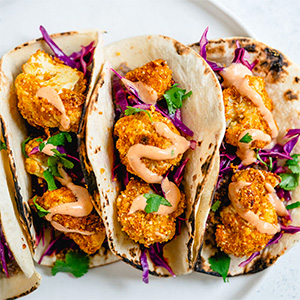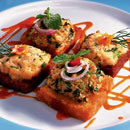A dozen baking flours -- and how to use them
Published in Variety Menu
Christmas, Hanukkah and Kwanzaa are fast approaching, which means a whole lot of home cooks are going to be wrist deep in flour, sugar and butter to craft their favorites cakes, cookies, muffins, yeasted breads and pastries for the holidays.
Since most grocery stores have a dizzying number of flours to choose from, you might be wondering: Which flour is the right one for a particular recipe?
It's a good question, because when it comes to flour, one size doesn't fit all.
Different grains contain varying levels of protein, and the more protein a flour contains, the more gluten it produces.
Formed when water or another liquid is added to flour, gluten — a protein that gives elasticity and structure — is what holds all the ingredients together. So generally speaking, you want more gluten for bread and other foods that are stretched, kneaded and folded, and less for tender baked goods like cake and cookies.
Bleaching flour with chemical agents like benzoyl peroxide and chlorine dioxide — which makes it whiter and softer — also alters the flour's protein structure, which can affect how a particular recipe turns out.
Bleached flour is self rising, explains Selina Progar, lead pastry chef for big Burrito Restaurant Group, and creates a finer texture and grain, which produces a more absorbent product that's able to take on more fat and eggs.
That makes it a great choice for fluffier items like cookies, pancakes and pie crust. Unbleached flour, which is aged naturally after milling through exposure to air, creates a dough that is more elastic. That makes it better for sturdier baked goods that require structure; think muffins, bread and biscuits.
But honestly, unless you're really nit-picky about the final product, it's really a matter of choice and budget, says Progar.
"A lot of people are looking for unbleached flour to avoid the added chemicals," she says, even though they do not appreciably change its baking qualities. "It's likely the average person won't be able to tell the difference between the two."
Here are 12 different types of flour used in baking — and which is best for whatever you're baking:
All-purpose flour
With a protein content that ranges from 9-11%, all-purpose flour is generally considered the workhorse of flours that works for all types of baking, says Angelo Madonna, a development manager who oversees the bakery department for Giant Eagle. "You can use it for a variety of items, because [the protein level] is right down the middle."
Progar agrees all-purpose is the best option for the home baker, because you're able to make pretty much anything with it — even bread, if you mix it long enough to produce a lot of gluten. (Though, it's always better to use a high-gluten or bread flour to make your loaves and baguettes because they have a higher protein content.)
Milled from the endosperm (the innermost kernel) of the wheat head, all-purpose flour is highly refined. That makes it very shelf stable, which helps reduce waste if you only bake occasionally.
Whole wheat flour
Often a higher-protein flour, whole wheat is milled from the entire wheat berry — bran, endosperm and germ. Because it makes an elastic dough (protein content is 13%) it is commonly used in yeasted breads.
"But I wouldn't make anything with just whole wheat flour," says Progar.
Bran has sharp edges that can cut the strands of gluten that form in the dough. "You have to soften it with other flours," she says, as well as add in resting time so it can absorb the liquid in the recipe.
White whole wheat flour
White whole wheat flour is exactly the same as whole wheat flour with one exception: It's made from soft white winter and soft white spring wheat instead of hard red winter and hard red spring wheat. (Winter wheats are grown in areas where the winter is gentle, such as Kansas or North Texas, and sown in the fall; hard spring wheats are grown in harder winters, such as Minnesota or Montana, and planted in spring.)
"It's literally the exact same flavor," says Progar. "It's just based on when it's planted and sown."
Pastry flour
With a protein content of around 8-10%, pastry flour is a soft, low-gluten flour that's great for making things you want to be tender and flaky — think biscuits, scones, cookies, pies and pastry doughs. But it comes at a cost: Pastry flour requires the addition of more solid fats than all-purpose flour in order to support structure to whatever you're making, says Progar.
Cake flour
This ultra-light, finer flour has even less protein (about 7%, give or take) than pastry flour. It also is almost always bleached, which lessens its ability to form gluten strands. It's good for exactly what it's named for — cake — as well as pastries.
"There's not a lot of gluten development, so you get a tender, light crumb," says Madonna.
Self-rising flour
Progar advises staying away from this specialty flour unless a recipe specifically calls for it because it's a "mixed bag" that already contains a leavening agent and salt.
"You just don't know how much baking soda (which causes batters and doughs to spread) or baking powder (which causes it to puff) is mixed in with the flour," she says.
Bread flour
As its name suggests, this high-protein, high-quality parent flour (12-14%) made from the center endosperm of the wheat kernel is used mostly in bread making. It is a "thirsty" flour that absorbs more water and therefore has greater gluten development, which produces better structured baguettes, rolls and artisan loaves. You also can make wonderful pizza crusts and chewy pretzels with it.
Semolina flour
If you've ever watched a pro make pizza, you probably are familiar with this coarse, pale-yellow flour made from durum wheat; it's what a pizzaiola dusts on the counter to keep the dough from sticking.
Since it has a higher gluten content than all-purpose flour (13% or higher), it's also used to make fresh pasta, certain Mediterranean cakes as well as flatbreads and pudding. Golden in color, with a nutty flavor, it also can be mixed with bread or all-purpose flour in bread recipes.
Double zero flour
Doppio zero, 00, or double zero flour is a finely milled Italian flour that is as soft as baby powder. It refers to the grind size (2 is the largest) and is made only with endosperm.
Available at Italian markets like Pennsylvania Macaroni Co., it is most often used to make pasta or Neapolitan pizza dough. The protein content varies (12-15%), depending on what kind of flour is used and the manufacturer's production process. It's less absorbent than bread flour, so you'll use less water to make a dough.
Rye flour
Most often used in bread baking, rye flour has a spicy, earthy flavor. It's made from ground rye berries "and absorbs a lot of water, so it has less gluten than wheat flour," says Progar.
Rye flour ranges in color from off-white to dark brown, depending on the milling process. (Pumpernickel, which contains the endosperm, the germ and the bran, is the darkest). It is heavier and more compact than wheat flour and creates smaller, denser loaves. When mixed with all-purpose flour, it also can boost flavor in cookies, cakes and brownies.
Almond flour
A popular choice for people going gluten-free, almond flour is made from blanched, skinned almonds. It has a fairly fine texture, and is often used to make macarons as well as a meringue-layered cake called Dacquoise.
"There are very specific things it's used for," says Progar.
Finely ground, it's less gritty than a coarser meal. Because it's full of fat, it can go rancid if not properly stored in an airtight container,
Gluten-free flour
"1-to-1" gluten-free flours are a blend of gluten-free grains and seeds — Bob's Red Mill blend is a mix of sweet white rice and whole grain brown rice flours, potato starch, whole grain sorghum flour, and both tapioca and xanthan gum (a powder used as a thickener or stabilizer). It will definitely work in cakes, brownies and cookies, says Progar, but if you're looking for a products that will produce a great loaf of bread, you will need to add a protein like whey or pea flour protein.
One of the more expensive baking ingredients, "it's not the same as wheat flour but it's passable for someone who can't eat flour," says Madonna. "And it's leaps and bounds better than years ago, when they were terrible. Every year, it gets closer and closer."
Some additional notes
Whatever flour you buy, Madonna recommends removing it from its paper packaging and storing it in an airtight container or canister in a cool, dark and dry space (such as your pantry).
All-purpose flour lasts up to 8 months at room temperature, but you can extend its shelf life — as well as kill any of the bugs that often infest flour, such as weevils or flour beetles — by freezing it. Just remember to bring it to room temperature before using; otherwise, it won't rise.
Also, while fresh flour doesn't really have a distinct smell, flour that's gone bad will smell lightly sour or musty. It also might include clumps or start to yellow.
©2024 PG Publishing Co. Visit at post-gazette.com. Distributed by Tribune Content Agency, LLC.










Comments